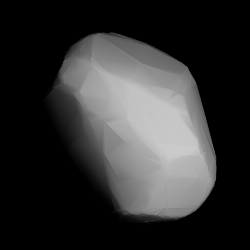1509 Esclangona, provisional designation 1938 YG, is a rare-type Hungaria asteroid and binary system from the inner regions of the asteroid belt, approximately 8 kilometers in diameter. It is named after French astronomer Ernest Esclangon.
925 Alphonsina, provisional designation 1920 GM, is a stony Hansian asteroid from the central region of the asteroid belt, approximately 58 kilometers in diameter. It was discovered on 13 January 1920, by Catalan astronomer Josep Comas i Solà at the Fabra Observatory in Barcelona, Spain. The S-type asteroid has a rotation period of 7.88 hours. It was named for the Spanish Kings Alfonso X and Alfonso XIII.
978 Aidamina, provisional designation 1922 LY, is a dark background asteroid from the outer region of the asteroid belt, approximately 79 kilometers in diameter. It was discovered by astronomer Sergey Belyavsky in 1922, and later named after Aida Minaevna, a friend of the discoverer's family.
1151 Ithaka, provisional designation 1929 RK, is a carbonaceous asteroid from the inner regions of the asteroid belt, approximately 14 kilometers in diameter. It was discovered by Karl Reinmuth at the Heidelberg-Königstuhl State Observatory in 1929, and later named for the Greek island of Ithaca.
3225 Hoag, provisional designation 1982 QQ, is a dynamical Hungaria asteroid from the innermost regions of the asteroid belt, approximately 5.5 kilometers in diameter. It was discovered on 20 August 1982, by American astronomer couple Carolyn and Eugene Shoemaker at the Palomar Observatory in California. The stony S/L-type asteroid has a short rotation period of 2.37 hours. It was named for American astronomer Arthur Hoag.

1245 Calvinia is a stony Koronian asteroid from the outer regions of the asteroid belt, approximately 30 kilometers in diameter. It was discovered on 26 May 1932, by South African astronomer Cyril Jackson at the Union Observatory in Johannesburg. The S-type asteroid is likely elongated and has a rotation period of 4.9 hours. It was named for the city of Calvinia in South Africa.
1717 Arlon, provisional designation 1954 AC, is a binary Florian asteroid from the inner regions of the asteroid belt, approximately 8.5 kilometers in diameter.
1453 Fennia, provisional designation 1938 ED1, is a stony Hungaria asteroid and synchronous binary system from the innermost regions of the asteroid belt, approximately 7 kilometers in diameter. Discovered by Yrjö Väisälä at the Turku Observatory in 1938, the asteroid was later named after the Nordic country of Finland. The system's minor-planet moon was discovered in 2007. It has a derived diameter of 1.95 kilometers and is orbiting its primary every 23.55 hours.
3800 Karayusuf, provisional designation 1984 AB, is a Mars-crossing asteroid and suspected binary system from inside the asteroid belt, approximately 2.5 kilometers in diameter. It was discovered on 4 January 1984, by American astronomer Eleanor Helin at the Palomar Observatory in California. The S/L-type asteroid has a short rotation period of 2.2 hours. It was named after Syrian physician Alford Karayusuf, a friend of the discoverer.
4904 Makio, provisional designation 1989 WZ, is a stony asteroid from the inner regions of the asteroid belt, approximately 8 kilometers in diameter. It was discovered by Japanese astronomers Yoshikane Mizuno and Toshimasa Furuta at Kani Observatory on 21 November 1989. It was named after Japanese astronomer Makio Akiyama.

1299 Mertona is a bright background asteroid from the central region of the asteroid belt. It was discovered on 18 January 1934, by French astronomer Guy Reiss at Algiers Observatory, Algeria, in northern Africa. The likely stony asteroid with an unknown spectral type has a rotation period of 5.0 hours and measures approximately 14 kilometers in diameter. It was named after English astronomer Gerald Merton.
1428 Mombasa, provisional designation 1937 NO, is a dark asteroid from the middle region of the asteroid belt, approximately 56 kilometers in diameter.
1536 Pielinen, provisional designation 1939 SE, is a stony Florian asteroid from the inner regions of the asteroid belt, approximately 7.8 kilometers in diameter. It was discovered on 18 September 1939, by Finnish astronomer Yrjö Väisälä at Turku Observatory, Southwest Finland. It was later named for Finnish lake Pielinen.
1796 Riga, provisional designation 1966 KB, is a dark asteroid from the outer region of the asteroid belt, approximately 70 kilometers in diameter. It was discovered on 16 May 1966, by Russian astronomer Nikolai Chernykh at the Crimean Astrophysical Observatory in Nauchnyj, on the Crimean peninsula. It is named after the Latvian capital Riga.
1979 Sakharov, provisionally designated 2006 P-L, is a stony Vestian asteroid from the inner regions of the asteroid belt, approximately 4.5 kilometers in diameter. It was discovered during the Palomar–Leiden survey in 1960, and named after Russian physicist Andrei Sakharov.
2478 Tokai, provisionally designated 1981 JC, is a stony Florian asteroid and binary system from the inner regions of the asteroid belt, approximately 10 kilometers in diameter. It was discovered on 4 May 1981, by Japanese astronomer Toshimasa Furuta at Tōkai Observatory, Japan. The asteroid was named after the city of Tōkai.
3401 Vanphilos, provisional designation 1981 PA, is a stony, eccentric asteroid and sizeable Mars-crosser, approximately 7 kilometers in diameter. It was discovered on 1 August 1981, by and at Harvard's Oak Ridge Observatory in Massachusetts, United States.

1534 Näsi, provisional designation 1939 BK, is a carbonaceous asteroid from the middle region of the asteroid belt, approximately 20 kilometers in diameter.
1523 Pieksämäki, provisional designation 1939 BC, is a stony Florian asteroid from the inner regions of the asteroid belt, approximately 9 kilometers in diameter. It was discovered on 18 January 1939, by Finnish astronomer Yrjö Väisälä at the Turku Observatory in Southwest Finland, and named for the town of Pieksämäki.
4440 Tchantchès, provisional designation 1984 YV, is a rather elongated Hungaria asteroid and a possible binary system from the inner regions of the asteroid belt, approximately 3 kilometers in diameter.



